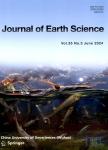Estimation of Cation Exchangeable Capacity and External Specific Surface Area of Homoionic Montmorillonite from Water Adsorption Isotherms
出 版 物:《Journal of Earth Science》 (地球科学学刊)
年 卷 期:2024年
核心收录:
学科分类:081803[工学-地质工程] 08[工学] 0818[工学-地质资源与地质工程]
基 金:supported by the National Natural Science Foundation of China (Nos. 41972298 42377192)
摘 要:This paper presents a method, based on Brunauer Emmett Teller (BET) theory, to estimate cation exchangeable capacity (CEC) and external specific surface area (SSAext) of homoionic montmorillonites using water adsorption isotherm. To this end, the dominant mechanism of water vapor adsorption by montmorillonite in different relative humidity (RH) range was firstly examined by analyzing the variation of basal spacing (d001) with RH, and the sequence of two hydration mechanisms, i.e., cation hydration and surface hydration, were identified in terms of their relative contribution to interlayer expanding. On this basis, the BET model was applied to analyze water vapor adsorption isotherm and the variations of shapes of BET-plots for different homoionic montmorillonites was interpreted from the view of the dependency of hydration sequence on cation type. By linking BET curve with d001variation curve, an approach based on BET-plot to distinguish the boundary RH value between cation hydration and outer/interlayer surface hydration was proposed. With this approach, the definition of monolayer water content was reconsidered and a method to predict the CEC and SSAextwas developed. The validity of the proposed method was examined by comparing the predictions with experimental results. It is shown that, depending on interlayer cation type, the adsorption of water could initially occur either on cation or on external surfaces. This behavior, on one hand, allows for extending BET model to CEC prediction, and on the other hand, implies that the conventional way of calculating SSAextfrom straight-line BET plot, without considering the effect of cation types, may be inappropriate for montmorillonite-rich soil.



